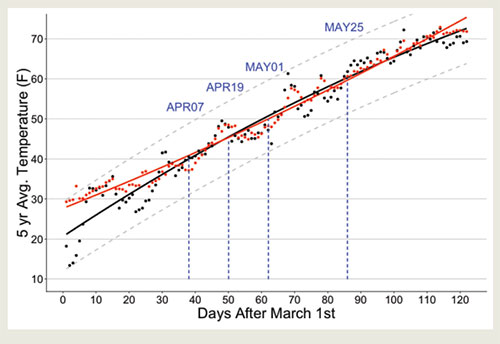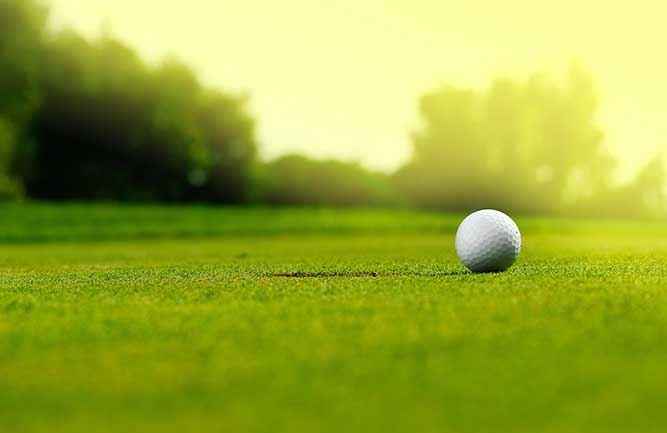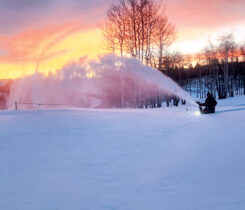Germinating creeping bent in the cold

Figure 1 Annual bluegrass winter kill in a putting green with green patches of creeping bentgrass that survived. (Photo: Sam Bauer)
As turf begins to green up in the spring (or not), superintendents need to quickly repair winterkill damage to putting greens to increase early-season revenue.
The term winterkill is a catchall phrase describing several stresses, including damage from cold-weather desiccation, intracellular freezing, anoxia from ice sheeting and cold-loving fungi. Whatever the exact cause, winterkill often is the source of springtime stress for golf course superintendents.
This past winter was particularly hard on golf greens, with several greens in the Twin Cities area losing spring playability altogether (Figure 1). Many areas of the Upper Midwest received rain in early January followed by extreme cold, leading to early ice accumulation in low areas followed by localized dead patches in the spring. This was bad news for any superintendent, but especially ones who maintain creeping bentgrass (Agrostis stolonifera L.) greens with Poa annua intermixed, since Poa is not winter hardy.

Figure 2 Typical temperatures observed in Minnesota throughout late winter and spring, based on a five-year average. The black dots and line represent air temperatures, while the red dots and line represent temperatures near the soil surface. The vertical blue lines represent experimental treatments used to determine cultivar germinability performance.
It’s well known that turfgrass species vary greatly in both days to germination and seedling vigor. For example, creeping bentgrass often takes six to 10 days to germinate, while perennial ryegrass (Lolium perenne L.) may germinate in as little as three days. Efforts to improve germination through cultural practices generally have led to poor results.
For example, applying polyethylene covers over spring establishments of creeping bentgrass following winterkill shows little to no improvement in the speed of germination and establishment. Cool spring conditions with nighttime temperatures averaging in the mid-30 degrees F for much of April (Figure 2) are the root cause of slow germination, lack of germination and subsequent establishment. However, within species (cultivars), there may be variation for germinability under these conditions of which superintendents can take advantage when overseeding creeping bentgrass greens in early spring.
Germinability
With this in mind, the turfgrass group at the University of Minnesota designed an experiment to determine temperature-specific guidelines for seeding creeping bentgrass based on realistic spring temperatures in the Upper Midwest and also to describe differences between 21 creeping bentgrass cultivars for their ability to germinate under suboptimal temperatures.

Figure 3 Germination test conducted at the University of Minnesota in a controlled environment. Temperature fluctuation and light duration mimicked spring conditions in the Upper Midwest. Each petri dish contained 100 seeds. (Photo: Garett Heineck)
The study was conducted at the University of Minnesota using controlled growing environment equipment that mimicked the diurnal temperature changes observed in the field at a 2-inch soil depth. Temperature treatments represented a range of average spring temperatures in Minnesota from April 7 to May 25 (Figure 2). We sowed seeds in petri dishes and measured germination events daily until germination ceased (Figure 3).
Collective seed germination, some-times referred to as germinability, is an interesting phenomenon to describe because of the different measures that determine success. Some superintendents simply may be interested in the number of seeds that germinate in relation to the amount seeded without regard to time (what we call maximum germination).

Figure 4 Graphical demonstration of a predicted germination curve. Single-value germination values plotted over the curve represent maximum germination, slope and time to 50-percent germination. Area under the germination curve (AUGC) is represented in the gray area below the curve.
However, when winterkill strikes, a superintendent may want to fill in bare areas as quickly as possible to increase early-season revenue and maintain healthy turf going into the summer months. Therefore, the amount of time in which germination begins to occur (time to 50-percent germination) and rate of germination (slope) are important parameters to consider (Figure 4).
Our research team integrated these ideas into our analysis, which relied upon a metric called the area under the germination curve (AUGC). This metric is similar to the area under the disease progress curve and takes into account the timing and amount of seed that is germinating. Discussing spring germination potential in terms of AUGC units gives a more comprehensible description; as AUGC units increase, so does early-season germinability (Figure 4).
Our findings showed that, indeed, as temperatures rose, so did the speed of germination. For example, there was no germination at an average temperature of 40 degrees F, which translates to typical early-April conditions in Minnesota. However, at conditions similar to late May, we found germination took only about nine days, which happens to be the same result under optimum textbook temperatures. Interestingly, we found the lowest temperature at which germination occurs was at an average temperature of 45 degrees F. This base temperature equates to typical late-April conditions and is the earliest we recommend overseeding bentgrass putting greens.

Figure 5 Select cultivar performance for temperatures mimicking late April. Fitted germination curves and AUGC values for the two worst-performing cultivars, Independence and Memorial, are outlined in brown, and the three best, Proclamation, Declaration and Pure Select, are in green. The larger the AUGC value, the better germinability under cold temperatures. Dotted red lines indicate time to 50-percent germination.
What happens if you seed earlier than this? In general, premature seeding, especially near the surface of the soil, increases loss in viability from rot and can result in seed predation by insects and small mammals. Additionally, we found that seeds treated with suboptimal temperatures often exhibited secondary dormancy, which greatly reduced maximum germination. We recommend watching soil temperatures near the soil surface and seeding when they reach 45 degrees F.
Cultivar matters
Our results showed that cultivar does play a role in early-season germinability. Proclamation, Declaration and Pure Select performed well in the late-April treatment, all accumulating at least 7 germination units, significantly higher than any other entry (Figure 5). Independence and Memorial, on the other hand, clearly were the worst-performing cultivars under late-April conditions, accumulating only 2.5 and 2.7 germination units, respectively.
We did not find substantial time variation in which germination began to occur. Cultivars generally took 14 days to reach 50-percent germination, although Independence was markedly slower than the top performers. Most important, the speed at which germination occurred (slope) was much greater in Proclamation, Declaration and Pure Select (Figure 5). This means superintendents need fewer seeds from the top-performing cultivars to fill winterkill patches. We observed few differences in AUGC between cultivars at late-May temperatures. Therefore, when seeding in late spring, superintendents can select cultivars based on other desired characteristics such as disease resistance and color, even if rapid germination is a priority.
Early establishment of creeping bentgrass after winterkill decreases the success of Poa annua germination and establishment, leading to long-term consistent playability in the spring. Creeping bentgrass is one of the most winter-hardy turf species, so a little extra effort in making sure your greens are predominantly creeping bentgrass will pay dividends in springtime revenue.
Our research determined that cultivar selection plays a role in early-season germination and should be considered before overseeding into winterkill areas. When using overseeding as a management tool, please note that new cultivars might create localized changes in color over time and create the potential for reduced aesthetics.
Editor’s note: A more extensive version of this research recently was published this year in the journal Crop, Forage & Turfgrass Management and can provide additional details on this research.
Garett C. Heineck, Andrew Hollman, Eric Watkins and Brian P. Horgan are at the University of Minnesota. Sam Bauer is with BauerTurf, Wayzata, Minn., and Matt Cavanaugh is at Rush Creek Golf Club, Maple Grove, Minn. You may reach Garett at heine237@umn.edu for more information.
References
Christians, N.E. 1998. Fundamentals of turfgrass management. MI Ann Arbor Press.
Frank, Kevin W., Bogle, Erica N., Bryan, Jeff M., Vargas, J. M. Jr. 2017. Putting green reestablishment following winterkill. International Turfgrass Society Research Journal. 13: p. 1-6.
Heineck, G.C., S.J. Bauer, M. Cavanaugh, A. Hollman, E. Watkins, et al. 2019. Variability in Creeping Bentgrass Cultivar Germinability as Influenced by Cold Temperatures. Crop, Forage & Turfgrass Management 5(1).













Hello. Live in salem oregon and would ile to plant creeping bentgrass to cover sand-topped putting surface. Will the bentgrass seed germinate in nov dec?
Thanks
Jack